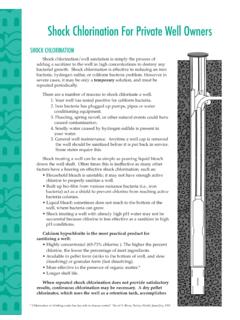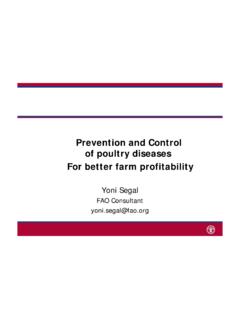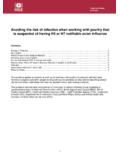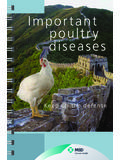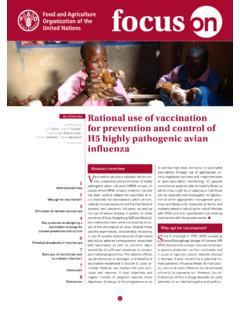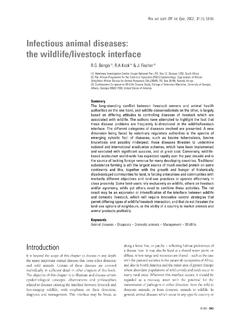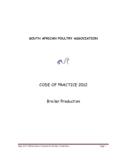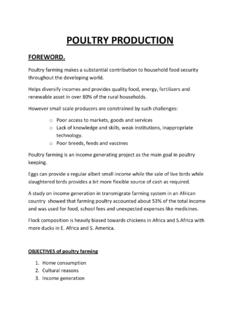Transcription of Chlorination For Poultry Water Supplies
1 Chlorination For Poultry Water Supplies Water : THE #1 NUTRIENT. Ask any veterinarian or feed specialist what the #1 nutrient is, and you may get a variety of answers. Poultry , however, will consume an average of twice as much Water as any other substance. Water is critical for any animal's health, but its importance is often overlooked when production problems arise. There are a number of Water -conditioning options, with Water softening, filtration, sequestering, and sanitizing, being the most common. Because bacterial contamination is the primary concern in Poultry production, the focus of this article is on Water sanitation. Water systems can become ozone, UV light, oxygenation, and hydrogen contaminated either from peroxide have all been promoted to get this job groundwater sources or from the done.
2 However, only chlorine has a well environment in the barn. It is documented biocidal residual. Chlorine residual is the chlorine that stays active in the system to possible for coliform bacteria to enter a insure continual sanitation. Without chlorine well due to poor construction, shallow- residual, disease-causing bacteria are free to ness of the well, or abandoned wells in recontaminate the Water system through the the area. However, the barn natural activity of the birds in the barn. Diseases environment is by far the biggest such as bordetellosis, coryza, blue comb, threat for bacterial contamination. salmonella, cholera, and intestinal tract enteritis Coliform bacteria is easily conveyed can all be spread through the watering system.
3 As to the waterers by the birds during these disease-causing bacteria are reintroduced to the watering system, they are continually being their daily activities. sanitized by the chlorine residual. Without There are a number of ways chlorine residual, these bacteria would multiply to control bacteria. Chlorination , unchecked. TYPES OF Chlorination . There are three common ways to chlorinate: 1. Gas chlorine is often used in large municipalities. It is the most economical, but also the most dangerous form of chlorine. Cities have trained employees to monitor gas Chlorination equipment. Because of its hazards, many cities have replaced gas chlorine with liquid or dry chlorine. 2. Liquid chlorine (sodium hypochlorite) is one of the most commonly used forms of chlorine in the Poultry industry.
4 It is available in strengths of 12-15%, but the most commonly used is liquid bleach at Liquid chlorine has the following limitations: Liquid chlorine has a poor shelf-life. In 3-4 months, half of the available chlorine may be lost. (Continued on pg. 2). (Liquid chlorine, continued ). Because of its aggressive nature, liquid chlorine is hard on chemical feed pumps. liquid chlorine is dangerous to handle. Low concentrations make it bulky and inefficient. It easily dissipates from holding tanks and open waterers. 3. Dry chlorine (calcium hypochlorite) is commonly found in strengths of 65-75%. chlorine. It is dispensed through erosion feeders, batch mixing, or dry pellet chlorinators. Erosion feeders are primarily used in swimming pools, where accuracy is not as important.
5 Batch mixing is labor intensive but very accurate. A dry pellet chlorinator -,because it is wired into the pump circuit - dispenses chlorine on a per-gallon-pumped basis. ADVANTAGES OF DRY CHLORINE. 1. Dry chlorine is proven to be more effective than liquid chlorine in the presence of organic matter.*. 2. Maintains a chlorine residual much longer than liquid chlorine.*. 3. Has a longer shelf life. Only loses 4-5% of available chlorine per year in storage. 4. Is highly concentrated. One gallon of dry chlorine equals 16 gallons of household bleach. 5. Is easy to store and handle. 6. Is safer to use. 7. Is more economical. WHAT IS DRY PELLET Chlorination ? A dry pellet chlorinator is most often mounted on the well and drops a compressed chlorine pellet down the well shaft into the well Water .
6 The chlorinator can also be mounted on a holding tank. It is wired into the pump's electrical circuit and runs only when the pump is running, metering chlorine in proportion to Water usage. An adjustment mechanism accounts for variation in pump size and Water quality. As the pellet sinks to the bottom of the well and dissolves in the Water , it releases chlorine that reacts with contaminants in the well. These contaminants may be living organisms, which can be sanitized, or dissolved solids, which can be oxidized. LIVING ORGANISMS IN Water . Recontamination of the watering system in making its way into the Water supply. Coliform a Poultry barn is a constant concern. Every bacteria may have no detectable smell or taste. time a bird drinks, contamination is possible The coliform itself may not be a problem, but is from coliform-type bacteria.
7 Nuisance bacteria, an indicator that other pathogenic bacteria may such as iron or hydrogen sulfur bacteria may also be present, causing diseases such as blue comb, be present from the well. coryza, bordetellosis, salmonella, cholera, and intestinal tract enteritis. Coliform Bacteria Coliform bacteria is the standard used in well Because chlorine is a sanitizer, it will kill testing. Coliform is present in many warm- these bacteria if applied properly. In blooded animals as a normal part of their laboratory conditions, chlorine at 1 ppm digestive tracts. Its presence in a Water supply residual, takes 20 minutes contact time to is an indication that animal or human waste is achieve 100% kill of coliform bacteria. If the 2. bacteria are exposed for less time or at lower levels, they sulfur, and sewer gas are common descriptions.
8 May still be present when the Water is consumed. By Hydrogen sulfide may lead to decreased Water dropping dry chlorine pellets into the well, treatment is consumption. It is also accompanied by a black, slimy started at the earliest possible time, and in most cases, accumulation that can cause many of the same problems the 20-minute mark will be met. as iron bacteria. However, in a Poultry barn, the bacteria are When chlorine is introduced into the Water lines, it: introduced into the Water on an ongoing basis. Warm weather encourages the bacteria to increase at a 1. Kills the bacteria causing the problem. dramatic rate. Maintaining a high chlorine residual will 2. Oxidizes the iron into a filterable form. keep these bacteria in check.
9 Poultry producers maintain varying chlorine levels, but 1-5 ppm in the 3. Breaks loose the slimy deposits coating drinker is common. the system. The amount that breaks loose depends on how high The sanitizing power of chlorine is dependent on the chlorine is and the severity of the problem. The the ph of the Water . When the ph is 7 or below, chlorine level of chlorine at which any system should be dosed acts predominantly as a sanitizer and will be very will depend on how the system reacts to the chlorine. effective at killing bacteria. At , chlorine will act equally as a sanitizer and oxidizer, but as ph rises, the Algae and Pond Scum chlorine will act predominantly as an oxidizer. The most common forms of chlorine - sodium hypochlorite Shallow wells and Water drawn from ponds may be (liquid bleach) and calcium hypochlorite (dry chlorine) - contaminated with surface runoff and biological debris may raise the ph of the Water .
10 Water that is at a ph of 7 from both plants and animals. Ponds are particularly or higher may need to be lowered for the chlorine to be prone to this, since they contain numerous forms of life at the optimum efficiency for killing bacteria. that can be drawn easily into the pump. These contaminants can be filtered out physically, but the Nuisance Bacteria Water should be sanitized for human or livestock consumption and for aesthetic and health reasons. Iron bacteria is most noticeable by the slimy, red Whether the contaminants are pathogenic or not can coating it leaves in the Water system. Severe cases can only be determined by a test, but these types of Water plug pumps, pipes and filters, increase operating costs, sources are subject to many variables affecting their and lead to premature pump failure.
